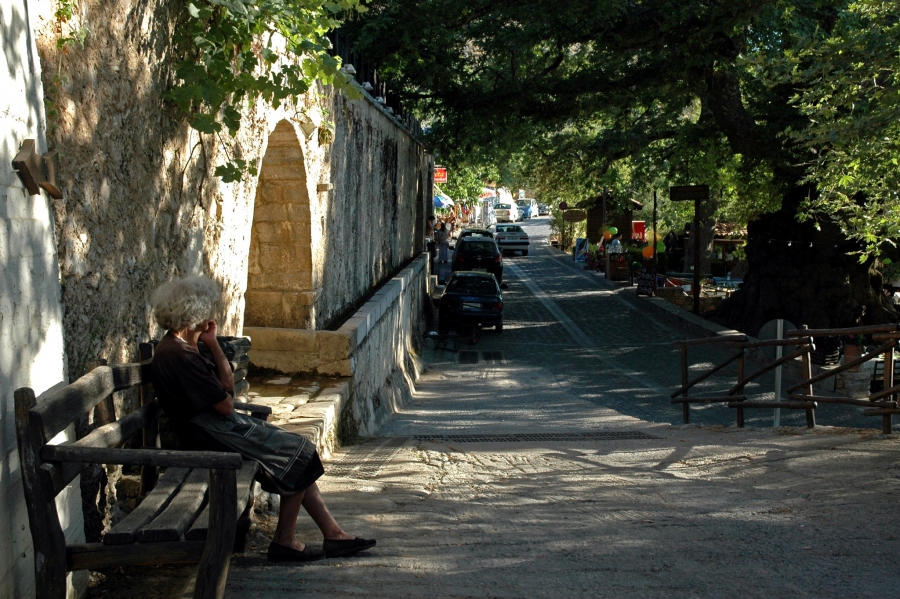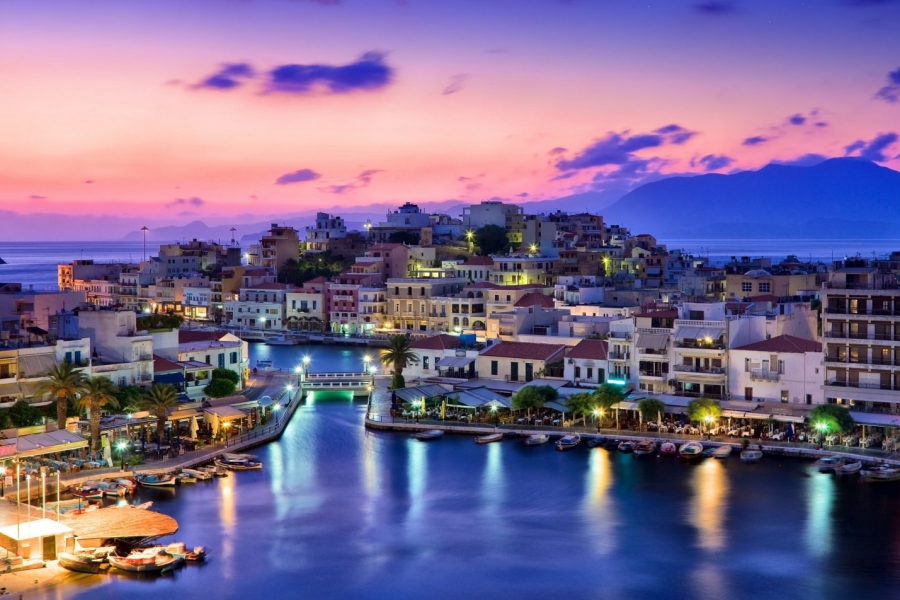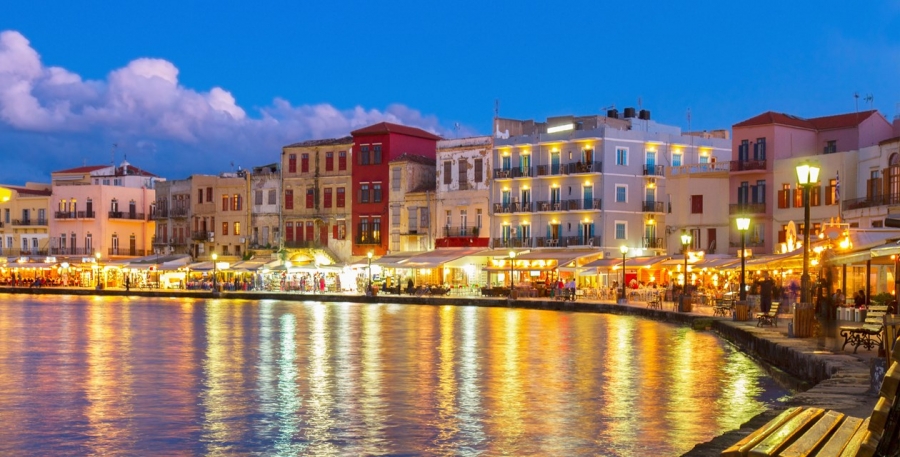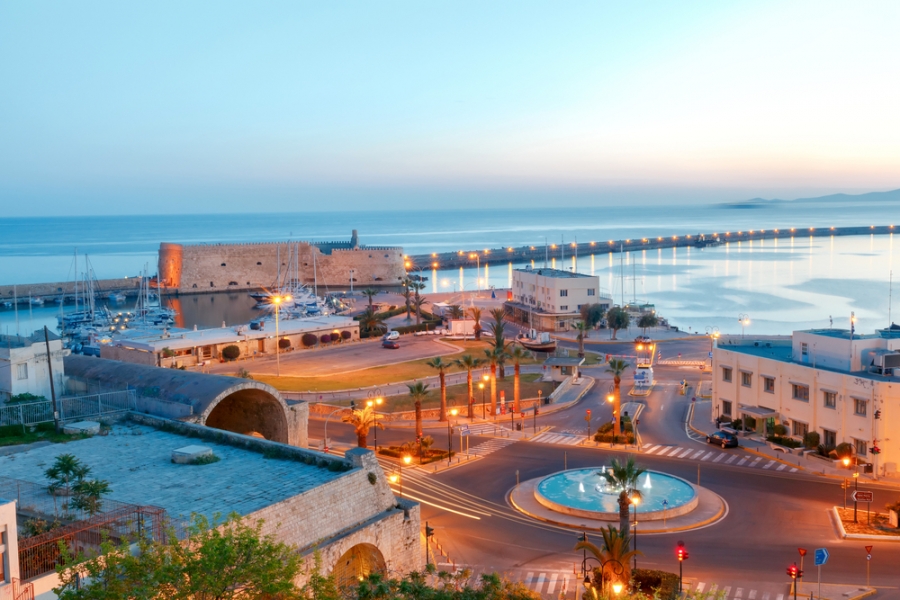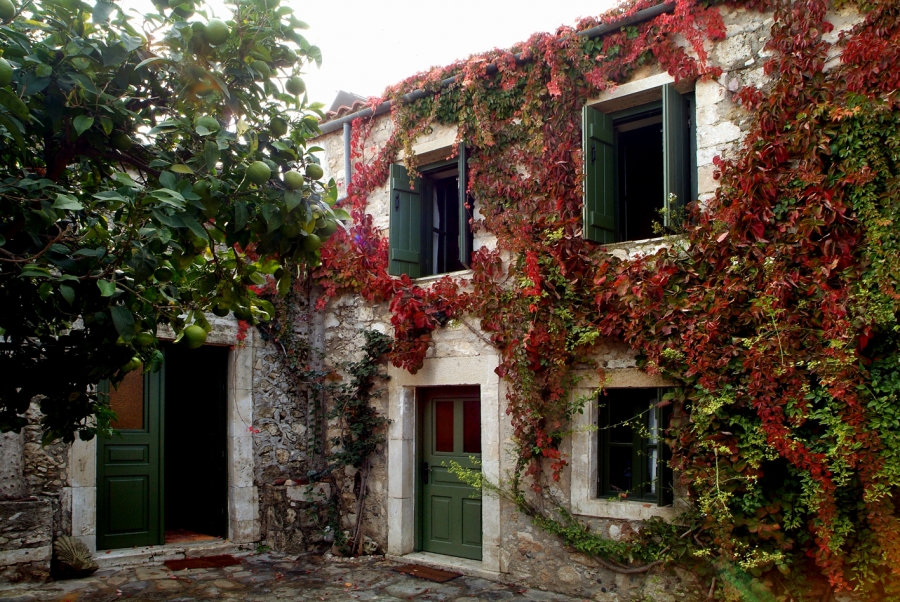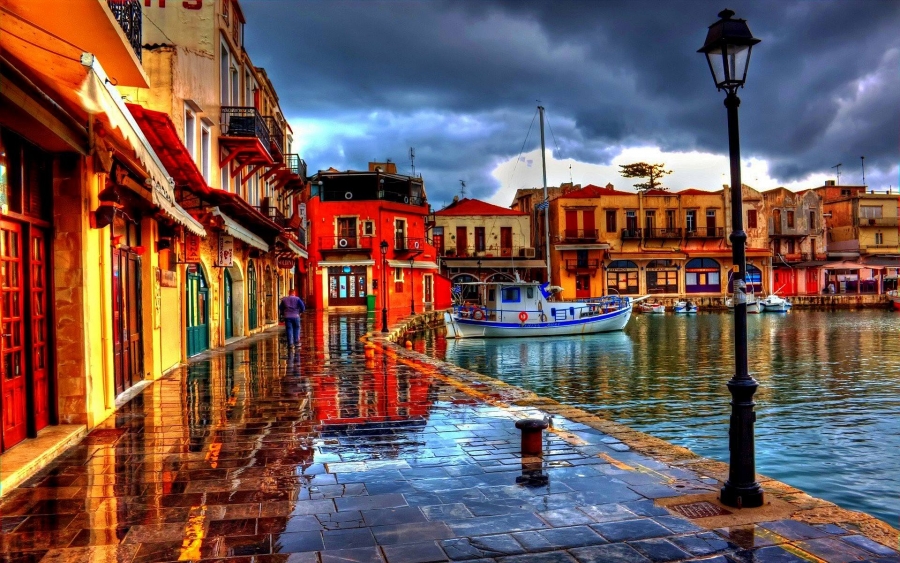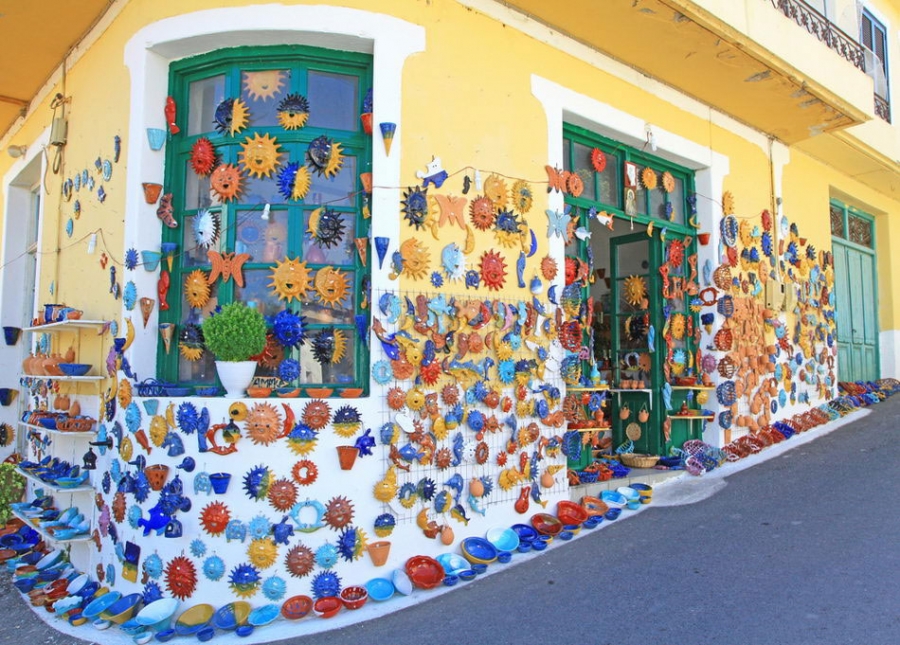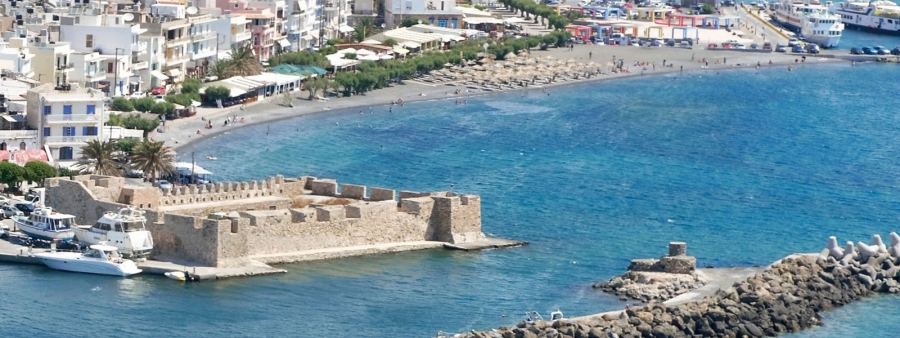Exclusive Private Services: Excursions, Shore Trips, Daily Tours & Transfers Contact Us
The village of Krasi is about 47 km away from Heraklion. It is situated west of the foot of Mount Selena (1559 m altitude, at the southern edge of a small plateau.
At the top of the village there is a large water reservoir called “Megali Vrisi” by the local people. Its abundant waters supply the village and water a large area of the plateau. The water reservoir was built in 1890, as an inscription on it suggests. It is a large rectangular stone-built construction, consisting of the reservoir and three arched openings on its northern side. Two of these openings were used to water animals in stone basins.
In front of the reservoir and after the asphalt street there is a small square with a centuries-old plane tree. Writers and scholars like Nikos Kazantzakis, the Alexiou family, Markos Avgeris and Kostas Varnalis used to visit this square in Krasi in the summer.
The city of Agios Nikolaos is built on the location of the ancient "Lato pros Kamara - port of Lato Etera". Both towns formed one administrative unit, which flourished during the 3rd century. Both worshipped goddess Elithyeia (goddess of childbirth) and they had the same coins - with Elithyeia or Artemis (Diana) on one side and Hermes Lation on the other - as well as their own economy. The Latians, contrary to other towns, which were almost constantly in war with other cities, were in good terms with their adjoining cities of Elounda, Driros, Milatos and Minoa. There is not enough reference about the Byzantine period. During the Venetian occupation (1204-1669) Genoan pirates built a castle on top of the Kefali hill (prefecture hill), which was renamed by the Venetians to Merabello and gave its name to the whole region. The castle has been destroyed by the earthquakes and burnt during the pirate raids. The city of Agios Nikolaos has been thrust aside during the years of the Turkish occupation and was reinhabited in the 1860's by fugitives from Sfakia, from Kritsa and other Cretans. In 1881 it was a small picturesque village of few people and in 1900 had 500 inhabitants. However, in 1905, it became the capital of the province.
Agios Nikolaos was named after the small Byzantine church of Saint Nicholaos, which is located next to the "Minos Palace" hotel. The church is carefully preserved.
The Archaeological Museum. The museum is situated on K.Paleologou St. , almost 400m away from the bridge and houses real treasures of the Minoan and the other periods of the history of eastern Crete.
The Popular Art Museum. Located next to the bridge at the beginning of K. Paleologou St., houses marvellous objects of the popular artcraft of the area.
Agios Nikolaos is the capital of the Prefecture of Lasithi, is one of the most highly developed tourist towns in Greece.
Agios Nikolaos is the administrative, communications, cultural and commercial center of the Prefecture, with approximately 8500 inhabitants.
The sea in Agios Nikolaos is superb and the surrounding area of the city is noted for its sandy beaches and beautiful bays - Kitroplateia, Ammos beach, EOT beach and Ammoudi are within walking distance from the city center.
The landmark of the city is definitely the small lake, known as "Voulismeni" that is located in the center of the city, at the foot of the cliffs. Its shape is circular with a diameter of 137m. According to the mythology, the goddess Athena used to take her bath in this lake. The depth of the lake is 64 m and was connected to the sea only recently, with a canal opened at 1870.
It is an especially picturesque site with many open-air cafes and restaurants along the bank.
A first-time visitor to Chania city is surprised by the great number of buildings and monuments with traces of great history and culture. The old town is located on and around the hill of Kasteli and was built over the ruins of the Minoan city Kydonia. It is surrounded by the Byzantine walls, the Venetian walls and the sea. The town of Chania, the first capital of Crete, kept its historical centuries-old heritage almost unaffected. Its flair has attracted scientists, philosophers, poets and artists from different countries and it has become a cultural centre. The Minoan civilization left behind grand tombs and interesting pottery objects.
During the Venetian and the Ottoman rule, people of different nationalities and religions co-existed. Christians (Catholic and Orthodox), Jews and Muslims, have left discernible traces and produced particularly interesting creations. In the neighborhood of Topanas with its narrow paved streets, the visitor meets Venetian manors with elaborately decorated facades and Turkish houses with architectural protrusions. The Fort of Firkas, the Naval Museum and San Salvatore’s church of the Franciscan Monks (15th – 17th cent. AD), hosting the Byzantine collection of Chania, are there. In the old Jewish neighbourhood is the synagogue and in Haledon Street the folklore museum (Cretan house) and the church of St. Francis. The church hosts the town’s archaeological museum and houses treasures from the Minoan to the Hellenistic period.
Opposite is the Cathedral of the Presentation of the Virgin to the Temple with its exquisite images of saints. Close to it are the old Turkish baths. In the area of Sintrivani, around the square with the same name, is the mosque of Küçük Hasan (1645) and opposite it the quay with the Venetian lighthouse. A little further you can see 7 of the originally 17 docks (14th-16th cent. AD). The Great Arsenal, which is used today as a convention and exhibition centre is eye-capturing. Along the harbour, small cafes and restaurants create an inviting atmosphere. On the hill of Kasteli there are still parts of the old Rector’s palace and its court. The excavation site of ancient Kydonia and the ruins of the church of St. Maria of Mirakoli (1615) are located near there.
At the “Stivanadika”, which still has oriental characteristics, one can buy leather goods. Next to it is Chrysostom’s building and the new public Art Gallery. In the old Turkish neighbourhood of Splantzia is the square of the former monastery οf St. Nicholas (1204) with a bell-tower and minaret. The small church of St. Rokkos (1630) of the Enlightenment can also be found there. The church of St. Anargyroi (16th cent. AD) with its priceless images of saints and St. Catherine’s church are near there. Outside the walls, in the east of the old town, we come across the Koum-Kapi, where during the last years of the Ottoman rule Bedouins built a village. Today the area is a popular meeting place of the young people. In the area of Halepa is the palace of Prince George, the house of Eleftherios Venizelos, the French School (1860), the church of St. Magdalene (1903) and the church of Evangelismos.
Other places are of interest from later years: “Villa Koundourou”, the Workshop of Fine Arts and the Youth Centre, the Municipal Park (1870) with its clock, the Market (built in 1913, a cross-shaped building with hundreds of small shops), the Park of Peoples’s Peace and Friendship, the Court House, the Prefecture, the “Venizelion” School of Music, the Historic Archives Museum, the War Museum and the Museum of Chemistry. In the neighbourhoods outside the walls there are many neoclassical buildings with beautiful gardens that smell of hyacinth, honey suckle and rose trees. In the area Akrotiri are the graves of Eleftherios Venizelos and Sofoklis Venizelos.
Heraklion is the largest city of Crete and one of Greece’s major urban centers. Its development begun in the wake of the 9th century AD (in antiquity, Knossos was the island’s most important center, followed by Gortyn). In later times, Heraklion came under Arabic, Venetian and Ottoman rule; its conquerors initially gave it the name Khandaq or Handak which was corrupted to Candia.
Among the most outstanding sights of Heraklion are the fortification walls that delimit the “old city”. The first fortifications were built by the Arabs and were later reinforced by the Venetians (15th century). From the seven bastions, only the Martinengo bastion survives to this day; there, visitors will find the tomb of the renowned writer N. Kazantzakis, overlooking the city. From the four gates to the city, the most important is Chanioporta (1570) with the characteristic winged Lion of Saint Marc and the New Gate (1587) at the southern side.
In the old (Venetian) port, next to the modern facilities, one can see the vaulted tarsanades where ships used to be built, while the western side is dominated by the Koule fortress (16th century).
In the heart of the city there are many monuments dating to the Middle Ages, a period in which Heraklion witnessed great prosperity. From the port, ascending 25 Avgoustou (August) street, one reaches a square where the church of Agios Titos is found (built in 1872 at the site where a Byzantine church once stood), while next to it lies the Venetian Loggia (16th century), a magnificent, ornate arcaded Venetian building decorated with blazons, trophies, etc., which served as a meeting place for the Duke and other noblemen during the Venetian period.
A typical feature of Heraklion is its Venetian and Turkish fountains, scattered all around the city. The most famous one is the Venetian-style Μorozini fountain, also known as the Lions (1628), a landmark for local inhabitants and visitors alike. Other noteworthy Venetian fountains are the Bembo fountain (1552-1554) on Kornaros Square, the Sagredo fountain (1602-1604) built in the northwestern corner of the Loggia, and Priuli fountain (1666) located near the port.
Among the churches of Heraklion, the one that stands out is the imposing and sizeable Metropolis of Agios Minas (on Agia Ekaterini Square), built between 1862-1895. Adjacent to it, stands the chapel of Mikros Agios Minas and on the northeast, is situated the church of Agia Ekaterini (16th century), which functionsas a museum housing exhibits from the Cretan Renaissance. The church of Agios Markos (13th century) towers over Venizelou Square, while other important churches in the city are the Monastery of Agios Petros and Pavlos, the Panagia Akrotiriani, the Panagia ton Stavroforon, etc.
One should not miss out on a visit to the Archaeological Museum, one of the most important museums in Greece; it contains almost all the unique treasures of the Minoan civilization unearthed at Knossos, Phaistos, Malia and other sites. Other museums that are worth visiting are the Historical Museum & the Museum of Natural History.
In the market of Heraklion, one of the richest in the Mediterranean, visitors can find all sorts of modern products, as well as traditional Cretan products such the famous Cretan olive oil,raki, local wine, honey, herbs, etc.
Archanes is a village built on the slopes of a low hill in a green area surrounded by olive groves and vineyards and has retained its name for thousands of years.
The area is dominated by the large mountain Giouktas, and gorges, forests and nature abound. The local agriculture produces delicious wine, raisins and grapes.
It was inhabitant in the Neolithic times (6.000BC). It reached its peak during the period 2500-1400 BC when the grand palace was being built in Archanes which was rebuilt on successive destructions it suffered over the years. During the first Byzantine period and the Arab rules, Acharnes and the surrounding area follow the same course in history as the rest of Crete, while under the Turks it was used as a base for Turkish officials. During the battle of Crete in 1941 (World war II) Acharnes was used as an administration centre of the Greek forces and later during the German occupation, the first espionage detachment was organized here.
The beauty of Archanes was acknowledged by the EEC, bestowing it the title “Total and sustainable development of excellent quality”. Not only can the visitor enjoy the beautiful Byzantine churches but a walk through the head village will give one the opportunity to admire the architecture. Fortunately, the results of the restoration programs of the traditional buildings can be easily seen and appreciated.
Rethymno is the capital town of the wider prefecture of Rethymno. It is located on the northern coast of Crete, at a distance of 80 kilometers from Heraklion. It is a town that uniquely combines the traditional and classy with modernity.
The old town of Rethymno is picturesque, with the beautiful Venetian harbor, the castle of Fortezza and its narrow-cobbled alleys. The old city of Rethymno still preserves its old urban structure to a great extent, formed during the Venetian period and later reformed during the Turkish occupation.
It has been declared a protected historical monument and a traditional settlement. Also, there is the Archaeological Museum, the Museum of Folklore and the Religious Museum.
The city of Rethymno is an ideal tourist destination for visitors who wish to explore the rich cultural heritage and the natural beauties of Crete. This well-organized city offers to visitors a variety of picturesque routes to follow and numerous historical monuments to visit.
The layout of Rethymnon is directly linked to the sea, with the main Venetian street, the Ruga Maistra (today's coastal Venizelou Avenue) running parallel to the sea.
The Venetian harbor. Rethymno's harbor area is a fine place for a coffee at one of the cafes and perhaps you will chance to eat there, just for the atmosphere.
The Fortress dominates the city and makes Rethymnon very photogenic, its pedestrian streets below, strewn with charming old buildings. Venetian influences abound and the minarets and domed mosques remind of the Turkish influence long gone.
Numerous shops for souvenirs (with many local products now available), trendy fashion or imaginative jewellery...the old and the modern combine to make a colorful and buzzing town.
The modern city of Rethymno provides the visitors with all kinds of amenities. It is also famous for its nightlife and hospitality.
The village of Margarites is a traditional settlement which is located 27km southeast of Rethymnon, near ancient Eleftherna.
Margarites is an old village known for its pottery production (is one of Crete’s four main pottery centres). The pots are handmade using techniques dating back thousands of years. Many craftsmen still use age-old traditional techniques and skills, whether for small pieces of pottery or the large storage jars used on the island in the Minoan period, as evidences by the large jars found in all Minoan palaces.
Various village shops sell the local pottery. The village has several remains from older eras and several Byzantine churches. Walking around the village one can see ornate doors and walls dating from the Venetian era. These features, as well as the narrow alleys, retain certain aspects of traditional Cretan village architecture.
Maroulas is a quiet village situated on the heights above Rethymno, facing the sea at an altitude of 150 meters and surrounded by greenery, a spring and several valleys.
In 1980, Maroulas was listed for its historical monuments but also for some of its houses.
Amongst its rich historical heritage, visitors can discover important remains of ancient tombstones dating back to antiquity, two wonderful Venetian towers one of which is 44 meters high, a Byzantine church dedicated to the Ascension, a more recent church dedicated to the Virgin Mary and lastly a small chapel with iconostasis which adorns the small village square.
During the first Venetian invasions, the middle-class houses of Maroulas were used as second homes or agricultural warehouses by the nobility of Rethymno.
Its high position facing the sea and its narrow lanes without any main square make Maroulas a typical example of the kind of fortifications built at that time.
Inspired by the works of Venetian engineer Fr. Barozzi dating from 1577, the Venetian constructions were aesthetically considered as state of the art.
Later, the Turks would add architectural elements from Anatolia like chimneys, wells, hammams or fountains.
Nowadays, Maroulas reveals itself through a maze of alleys where visitors can stroll, meet with the locals and enjoy its tavernas and cafes.
The town of Ierapetra is present throughout the history of Crete. According to the myths, Cyrbas was one of the first settlers. The town was initially called Cyrbas, from the name of its founder.
Later it was called Kamiros, Pytna, Ierapytna and eventually Ierapetra.
Growing from the early years of the ancient Cretan civilization, this gifted and strategic corner of Europe has always a strong point of interest and activity. Ancient Ierapetra will reach her peak during the 2nd and 1st century BC.
The town rules a very large area of southeast Crete which includes the once powerful cities of Pressos, Priansos, Malla and Oleros which once blocked her expansion. Ierapetra resisted the Roman invaders harder than any other Cretan city, however it was destroyed by the conquerors in 66 BC.
It was rebuilt to a magnificent city according to the Roman model with a theatre and other public buildings.
In the Byzantine period Ierapetra sustained her significance but was destroyed by the Saracens in 828 AD who rebuilt it partially mainly to use it as a center of piracy operations.
Today the area of Ierapetra is one of the most productive regions of Greece and one of Europe's main sources of early fresh fruits, vegetables, olive oil and flowers. The population is employed in agriculture -mainly in all year round cultivation of vegetables.
Large quantities of vegetables, which are grown in green houses (a total area of 13.000.000 square meters), are exported to whole Europe.
There is also considerable income from the abundance of fresh fish brought in by the fishermen who ply the waters to the south and east Crete.
Ierapetra has a lot to offer to its visitors! Whether you prefer a quiet, peaceful holiday enjoying the beautiful nature and traditional Greek atmosphere.


